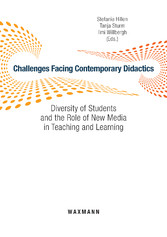Suchen und Finden
Service
Mehr zum Inhalt

Challenges Facing Contemporary Didactics. Diversity of Students and the Role of New Media in Teaching and Learning
Contents
6
Preface
8
Introducing didactic perspectives to contemporary challenges
10
A concept of Didactics: Allgemeine Didaktik
11
The challenge of Diversity and New Media in teaching
13
Content of the book
18
References
20
Diversity
24
‘Doing differences’ – a Matter of Teaching and Learning Concepts
26
Abstract
26
1 Sketch of the problem
26
2. “Doing difference” in teaching practice
28
3. Methodological frame and methods worked with
30
4 Orientations in teaching concepts
31
5 Discussion and Perspectives
39
References
40
Capacities in Diversified Classrooms
44
Abstract
44
1 Current on-going changes in education in the context of school accountability
46
3 Students as capacities in education
52
4 Conclusion
56
References
57
The Role of Imagination when Teaching the Diverse Group
62
Abstract
62
1 Introduction
62
2 The role of imagination in Didaktik
64
3 The semantics of teaching
66
4 Discussion: The challenge of group diversity
70
5 Conclusion
72
References
73
Gender
76
The Professional Student – a Matter of Gender? Learner Responsibility in Upper Secondary Schools
78
Abstract
78
1 Introduction
78
2 Learner responsibility for school learning
79
3 Method
81
4 Students’ apprehension of responsibility versus freedom
81
5 Discussion
88
References
91
Gender and Didactics: How to Teach Gender Theory
94
Abstract
94
1 Introduction
94
2 Dealing with gender in higher education
95
3 Experiments on gender-learning: Shopping mall, nail polishing, walking and sitting like a man or a woman
100
4 Gender and didactics: Gender sensitivity
107
References
109
Double Socialisation: Gender and Disciplinary Cultures in Higher Education
114
Abstract
114
1 Introduction
114
2 Beginner students’ double socialisation into academic and student culture
115
3 Male students’ statements: disadvantages of being a minority?
118
4 Synopsis and conclusion
124
References
126
Media
128
Media, Bildungstheorie and Didactics1
130
Abstract
130
1 The term ‘Bildung’
130
2 Media Bildung
135
3 Summary
139
References
139
Gender Mainstreaming and Diversity Management in E-learning-projects
144
Abstract
144
1 Gender Mainstreaming (GM) and e-learning
144
2 Checklists and quality guidelines as contribution to gender mainstreaming and gender-sensitive didactics
145
3 Insights and consequences drawn from the research on e-learning
147
4 Summary: consequences for the implementation of a gender-sensitive strategy
155
References
156
Mimetic Didaktik: Why “The Medium is the Message” in Teaching
158
Abstract
158
1 Introduction
158
2 Theory
159
3 Discussion
161
4 Conclusion
167
References
167
The Role of Worksheets in Media Based Instruction
170
A Didactic and Diagnostic Approach Abstract
170
1 Media based learning environments – and learning theories
170
2 The relationship of New Media and Instruction
171
3 The research study’s underlying theoretical framework
172
4 The art of asking questions
173
5 What are worksheets?
175
6 Summary
181
References
181
Gaming and Learning: Theory, Research, and Practice
186
1 Introduction-What is learning by gaming about?
186
2 Complex information processing is more than cognitive processing
187
3 Gaming attributes and characteristics revisited
190
4 Didactic implications
192
5 Summary
197
References
197
About the authors
200
Alle Preise verstehen sich inklusive der gesetzlichen MwSt.









